|
Report
from Europe
and the UK
EU tropical hardwood imports cool during 2008
Newly released trade data reinforces anecdotal reports of a
significant slowdown in Europe¡¯s hardwood imports from
tropical countries this year. However, the news is not all
bad. There has been growth in imports of some
commodities into a few countries. Plywood imports from
tropical countries increased significantly in the second
quarter of 2008. In addition, EU imports of hardwood
flooring have been rising this year.
The following series of tables provides data on EU
hardwood imports from tropical countries during the first
half of 2008. The data draws on an analysis of Eurostat
statistics undertaken by Forest Industries Intelligence
Limited. The data covers 22 of the 27 EU countries (data
for Spain, Denmark, Estonia, Bulgaria and Romania was
not available at time of this review). All intra-EU trade in
tropical wood products is excluded from the analysis. Note
that the term ¡®tropical country¡¯ is taken to include those
countries like China and Brazil that are partially located in
the tropical zone. And due to rising trade in temperate
hardwood species with tropical countries, hardwood
products imported by the EU from some tropical countries
is likely to comprise both tropical and temperate species.
The fall in EU imports of hardwood logs from tropical
countries has been particularly dramatic this year. Overall
imports of hardwood logs from tropical countries by the
22 EU countries reached around 380,000 m³ in the first
half of 2008, down over 15% on the same period in 2007.
While tropical log imports into Belgium and France held
up reasonably well during the review period, there were
dramatic falls in imports of this commodity into Italy
(down 33%), Portugal (down 26%), Germany (down 44%)
and Greece (down 14%). Considering leading supply
countries, log imports from Congo Republic and Gabon
were up 23.5% and 3.6% respectively during the first six
months of 2008 compared to the same period in 2007.
However, log imports from all other leading supply
countries including Congo DR, Cameroon, CAR and
Equatorial Guinea declined dramatically.
EU country imports* of hardwood logs from tropical countries Jan-Jun 2008
(m3 volume)
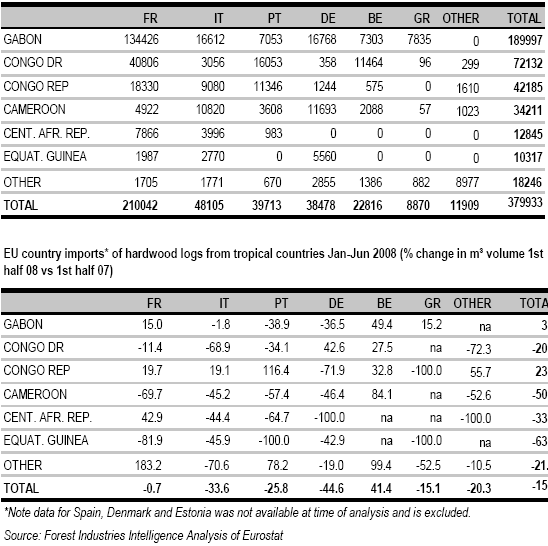
Imports of hardwood rough sawn lumber into the 22 EU
countries hit around 825,000 m³ during the first six months
of this year, down 12% on the same period in 2007. Of all
the main EU markets for tropical rough sawn lumber, only
Portugal and Italy maintained imports at a level similar to
the previous year. Imports into the Netherlands, France,
Belgium and the UK were down respectively 8%, 9%,
27% and 26%.
Tough supply conditions in Brazil were reflected in a 21%
drop in imports of rough sawn lumber from that country
during the review period. Sluggish European demand,
particularly for sapele, is reflected in a respective 15.4%
and 12.3% drop in imports of rough sawn lumber from
Cameroon and Côte d¡¯Ivoire. Imports from Malaysia were
also down nearly 10% during the review period. However
the EU has been importing more rough sawn lumber from
Gabon, Congo DR, and Congo Republic this year.
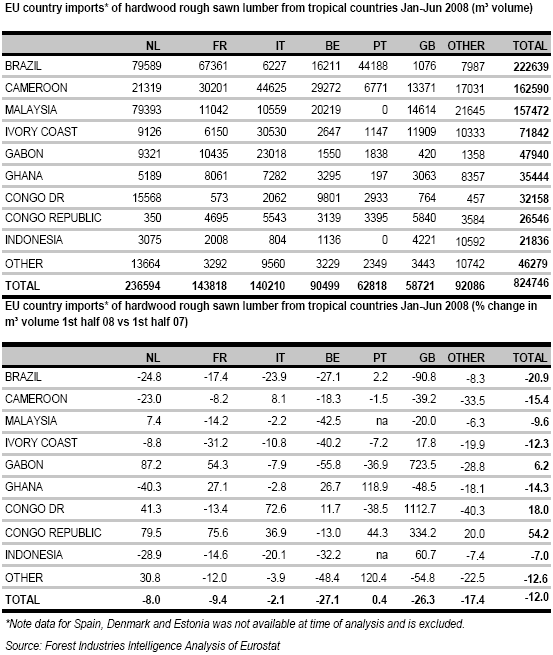
EU imports from tropical countries of planed, sanded and
finger jointed hardwood lumber have held up more
strongly than imports of rough sawn. Overall imports of
this commodity into the 22 EU countries during the first 6
months of 2008 stood at 65,000 m³, only 2% down on the
same period in 2007. The vast majority of this commodity
imported into the EU is destined for either the Netherlands
or France. During the review period, imports of planed,
sanded and finger-jointed hardwood lumber increased
from both Cameroon and Malaysia, the two leading
tropical suppliers of this commodity to the EU. There are
also signs of improved availability of these added value
products from Côte d¡¯Ivoire this year. However imports of
planed, sanded and finger jointed hardwood lumber were
down from Brazil and Indonesia during the six month
review period.
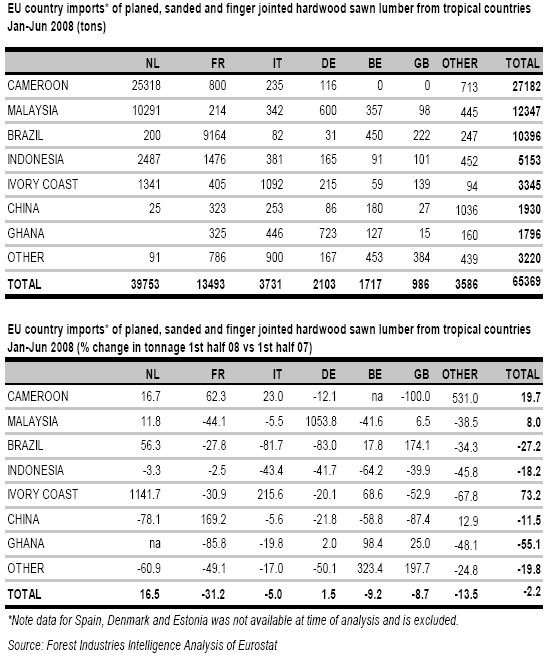
EU imports of hardwood veneer from tropical countries
also held up well during the six month period. Total
imports into the 22 EU countries between January and
June 2008 amounted to around 190,000 m³, up 4.5% on
the same period in 2007. Imports from Gabon, by far the
leading tropical veneer supplier to the EU - mainly rotary
veneers destined for France - were down 4.1%. However
EU imports of hardwood veneers from Congo Republic
have increased dramatically this year, with the majority of
extra volume destined for France. Italy and Germany have
also been importing larger volumes of veneer from Ivory
Coast this year. The EU has been importing more veneer
from China this year, although overall volumes still
remain small at just over 8,000 m³ during the first six
months of 2008.
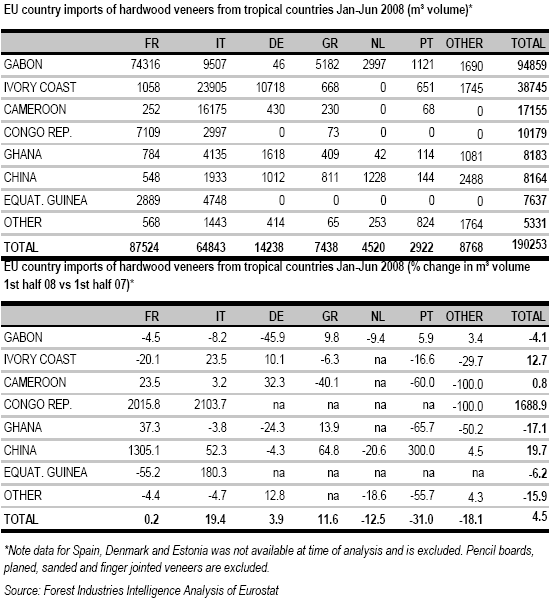
Imports of hardwood plywood into the 22 EU countries
from tropical countries reached 817,000 m³ during the
opening six months of 2008, around 4% up on the same
period in 2007. After a slow start to the year, EU
hardwood plywood imports picked up in the second
quarter of 2008, particularly into the UK. However the
data suggests that EU imports of hardwood faced plywood
from China, which increased dramatically during the
2006-2007 period, may have hit a ceiling. Anecdotal
reports of mounting supply problems are reflected in a 9%
drop in EU imports of hardwood plywood from China in
the first six months of 2008 compared to the same period
in 2007. Meanwhile EU imports from Malaysia have
increased sharply, up over 50% during the first half of
2008 compared to the same period of 2007. There has also
been a partial recovery in EU hardwood plywood imports
from Indonesia this year.
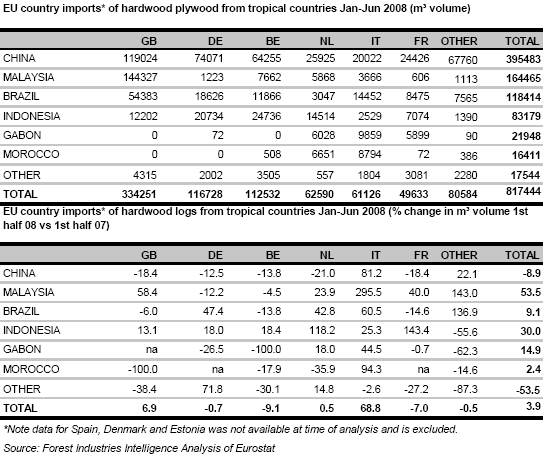
The analysis also includes data on EU imports from
tropical countries of flooring products ¨C covering parquet
panels for mosaic floors and multi-layer products together
with unassembled blocks and strips for parquet or wood
block flooring. Imports of these products into the 22 EU
countries from tropical countries increased dramatically
during the first six months of this year, up 23% compared
to the same period in 2007 to stand at 16.4 million m². The
vast majority of this product ¨C around 10.9 million m² ¨C
derived from China, with lesser volumes coming from
Indonesia, Thailand and Brazil. While EU consumption of
wood flooring has been rising in recent times, such a rapid
increase in imports is indicative of mounting competitive
pressure on Europe¡¯s domestic flooring manufacturers.
This may in turn feed through into declining EU demand
for flooring grades of hardwood sawn lumber.
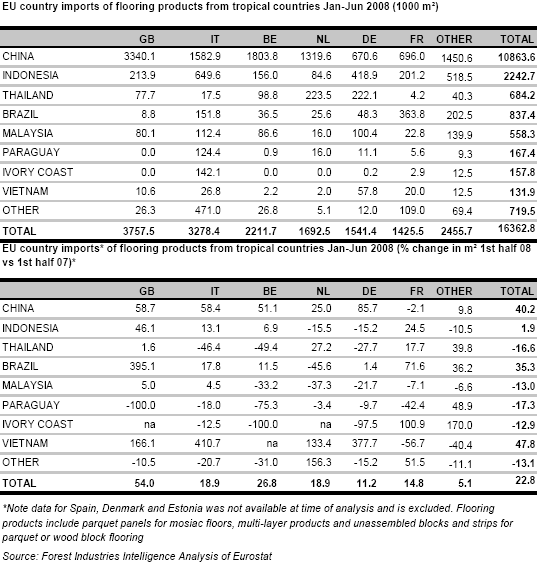
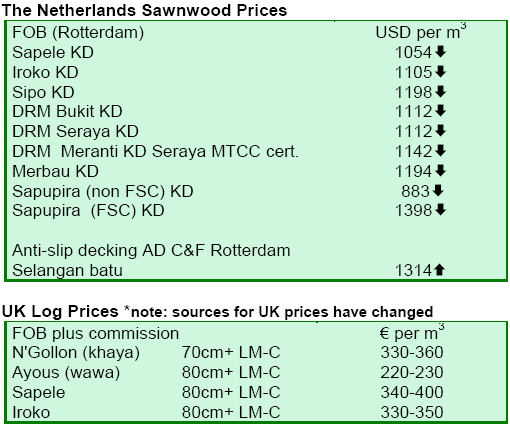
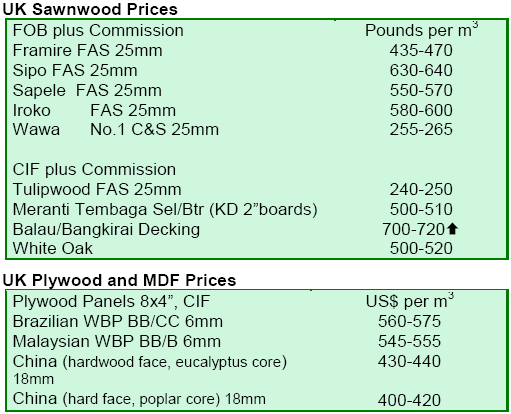
|